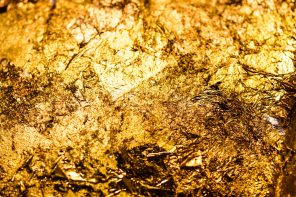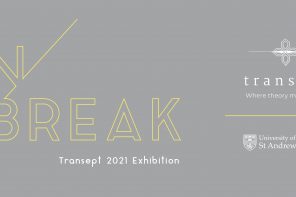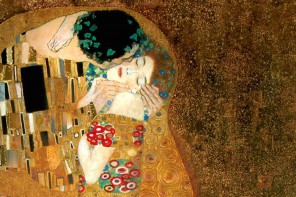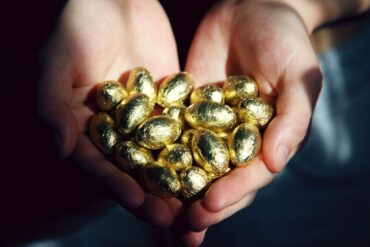The Ash series of paintings allude to life cycles and memory, to imply states of mind surrounding death and the unknown. The work was not consciously conceived, but when the lava-like mixture of oil paint and wood ash was applied to the canvas, the process prompted an extraordinary release from the interminable stress of anticipatory grief. I used rose madder, and later gold leaf, to immortalise the imagery. The images resembled built structures and fire; dramatic hatching with aspirational, angular lines dominate the picture plane.
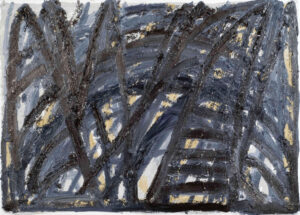
Head On (2008) and Falling House (2008) were made at the halfway mark of my husband’s protracted terminal illness. Diagnosed in 1996 with Stage Four cancer, the outlook was bleak. Following the identification of extensive liver metastasis in 2000, an experimental medication (for renal cell carcinoma) Interferon was used with unexpected success, extending his life by fifteen years. As his primary Carer with a young family, this was a demanding time. Painting afforded an opportunity to assuage the fear of anticipatory grief yet the practical demands of carer duties interrupted a cohesive studio practice. The Ash series was made after new tumour growth was identified and a six-week prognosis re-issued. Created in the kitchen between meal preparation, by scooping wood ash from the fireplace into a mixture of oil paint, linseed oil, turps and the medium Liquin, the images can be seen to represent a personal void.
I wrote about the significance of materials with symbolic properties and associations when I curated the exhibition Matière, in 2015. ‘Found, natural materials such as wood ash, were used in the paintings made in 2008-2009, to allude to the mystery and power surrounding death and the unknown. Sombre colours and a reduced palette (earth tones, charcoal, gold leaf) are used for their ability to imply states of mind, specifically anticipation of loss. Falling House (2008), Burning House (2008) and Burning (2008) are images that confront personal void. The method of applying the mud or lava-like substance assuaged stress. It combined the immediacy of drawing with a primal substance, a necessary catharsis’.1 Ashes are profoundly symbolic evoking: ‘finality, irrevocability, symbolising the end of love, a gutted structure. Yet ash is also associated with the sacred and the essential’.2
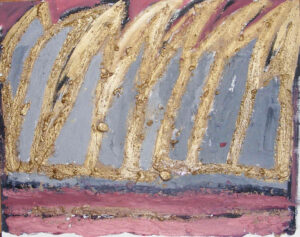
Although I was glad and relieved to have made the paintings, they were inscrutable. I was grateful for the observations of our neighbour, author Christopher Rush, who visited and wrote a beautiful letter in response. He observed that Falling House (2008) alludes to the building of a house, a home, a family, ‘which is itself a leap of faith: to see it crumble to ash represents the loss of life, the loss of faith. But in Burning House (2008) the fire, which destroys, also purifies. And out of its own ashes rises the Phoenix that resists destruction and obliteration. In Burning House (2008) there are phallic flames – of course! – But also, the plumes of the Phoenix’.
Rush wrote of the Wormiston Wood works (July 2008) quoting ‘The Wood’s in Trouble’ by A.E. Housman: ‘The wind in the wood is a great metaphor for the human spirit, and for what is happening to you now: the anger, the ashes, the futility, the hurt. And yet – that connection, through nature, with the timeless and universal emotions, that are the same as yours. Housman looked on this as a spectator, somewhere in Shropshire. Your home – and therefore your life – are actually in the wood, so you are a more immediate part of it: the wood and you are one’.3 The use of gold leaf Rush connects with the medieval gold leaf used by monkish illuminators: the colour which, along with blue, always represented eternity in early medieval painting.
I had absorbed conceptual views and processes from the work of Joseph Beuys, especially the work he did on Rannoch Moor, Scotland in the 1970s on the invitation of Richard Demarco, who explains: ‘Beuys’s art exhorts us “to show our wounds” and to use the language of art as a blessing upon the suffering of humanity and as a message of hope’.4
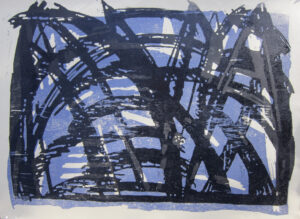
Anselm Kiefer too was an influence, particularly the inspirational exhibition of his work at White Cube, London in 2007, which I reviewed for Studio International.5 ‘Aperiatur Terra’ takes a quote from the Book of Isaiah as its title and, in doing so, conjures images of destruction and re-creation, apocalyptic trauma and spiritual renewal with originality and drama. ‘Aperiatur terra et germinet salvatorem, et institia oriatur simul‘ translates as, ‘Let the earth be opened and bud forth a saviour, and let justice spring up at the same time’. Kiefer is clearly aware that in both pagan and early Christian iconography, the palm was an immortal tree – its sword-like branches never died. The palm was, ‘The traditional Greco-Roman symbol of military triumph, which was adapted by early Christianity as a sign of Christ’s victory over death and rapidly expanded, under persecution, to serve as a universal emblem of martyrdom’.6 When a limb falls, new sheaths bud. Kiefer’s imagery and ideas are akin to Christopher Rush’s observations of the 2008 paintings made independent of Kiefer’s oeuvre.
Head On was an angry passionate response to my family’s untimely confrontation with mortality. Five years later I used it as the basis of a series of chainsaw woodcuts. The final results were surprisingly theatrical and architectural given the destructive connotations of a chainsaw especially when the initial carved blocks were combined with silkscreen printmaking techniques and a fine electric engraving tool.
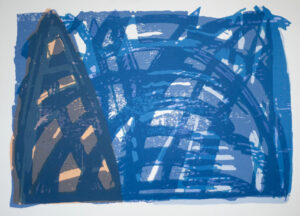
Edition of 20.
The chainsaw woodcuts also entitled Head On (2013) combined silkscreen methods (with the assistance of master printer Arthur Watson). They embrace the matière of wood, inspired by its beautiful grain, but also the universality of the meaning of trees through centuries and across cultures. The chainsaw evokes images of destruction of the land historically in environmental terms and yet, in spite of it being a vicious and quite dangerous process, the drawings that resulted were delicate and created a fine patina when printed. Titles of the woodcut prints (before the images were photographically transferred to silkscreens and editioned) included: Palm Sunday, Poisoned Earth and Vestiges (2013) referring to the physicality of image making that are at once informed by the Judaeo-Christian heritage and urgent environment issues. The processes enable one to side-step or avert the personal experiences that prompted the initial 2008 work, for a more conceptually-based body of work.


